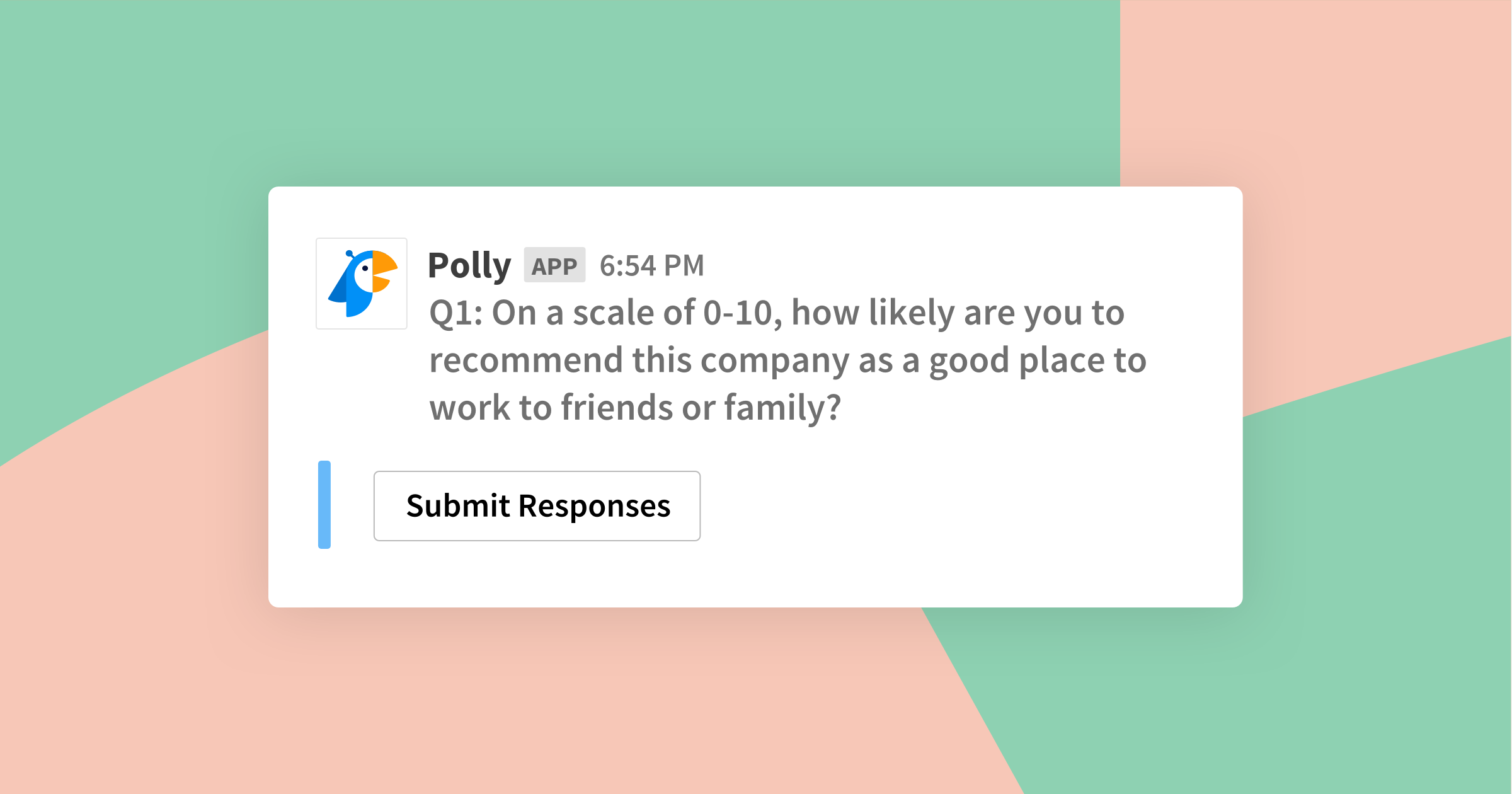/Net%20promoter%20Score%20fun%204.png?width=2000&height=1000&name=Net%20promoter%20Score%20fun%204.png) Most of us have heard of the Net Promoter Score. It’s a method that helps companies understand how their customers feel about their company or brand. There’s a similar method for employees, too — the employee Net Promoter Score, or eNPS.
Most of us have heard of the Net Promoter Score. It’s a method that helps companies understand how their customers feel about their company or brand. There’s a similar method for employees, too — the employee Net Promoter Score, or eNPS.
In this guide, we’ll share:
- What the eNPS is
- How the eNPS survey works
- The benefits of running eNPS surveys
- How to get higher engagement and scores from your eNPS surveys
Let’s jump in and explore what eNPS surveys are and why they’re a must-have for companies that want to understand their employees and create a better experience.
What is the eNPS?
 The employee Net Promoter Score gives you a helpful and easy way to understand how your employees truly feel about your company. This simple survey asks your employees to rate your company on a scale, giving you an insight into how happy they are, how likely they are to recommend you to others, and how loyal and engaged they are.
The employee Net Promoter Score gives you a helpful and easy way to understand how your employees truly feel about your company. This simple survey asks your employees to rate your company on a scale, giving you an insight into how happy they are, how likely they are to recommend you to others, and how loyal and engaged they are.
This employee-focused survey is built on the foundations of the Net Promoter Score (NPS), created by Fred Reichheld of Bain & Company. But instead of measuring customer loyalty and customer satisfaction, the eNPS helps us understand employee loyalty and happiness. It’s a simple survey that can help you foster feedback culture.
How the eNPS survey works
An eNPS survey asks respondents one key question: “On a scale of 0-10, how likely are you to recommend our company as a place to work?”
From this, your team members’ answers filter into three categories based on how they scored you. These categories are:
- Promoters: Highly engaged employees that rated you 9 or 10 🤩
- Neutrals: Somewhat engaged employees that rated you 7 or 8 🙂
- Detractors: Employees that rated you anywhere between 0 and 6 😞
To get your eNPS score, you then use a simple eNPS formula:
eNPS score = total % promoters – total % detractors
If your score is positive, you have more promoters than detractors. That’s a good eNPS score to have. If it’s negative, you have a company or team culture problem on your hands: more unhappy employees than satisfied ones.
Understanding the different groups
The distinction between neutrals and promoters is that the promoter group is more likely to recommend your company to their friends and family members. It’s your promoters who might suggest a friend for a role with you or encourage their friends and family to stay loyal to your company for a number of years.
While neutrals (also known as passives) are generally happy, they’re not likely to promote you — but they’re not likely to complain or give negative feedback either. Instead, these employees tend to remain consistent in their sentiment and represent the majority of people at your organization.
The group you need to pay the most attention to is your detractors. Employees who score your organization in the bottom half of the scale are unhappy, dissatisfied, disengaged, and unlikely to recommend you to others. A high number of scores at this end of the scale should prompt you to take action swiftly to build positive employee relations and create a better work environment.
The benefits of running eNPS surveys
/Net%20promoter%20Score%20pro%204.png?width=2000&height=1000&name=Net%20promoter%20Score%20pro%204.png) Your eNPS survey can give you an insight into employee sentiment and happiness. Not only does this give you valuable data to work with, but it can help you identify trends and spot problems before they become unmanageable.
Your eNPS survey can give you an insight into employee sentiment and happiness. Not only does this give you valuable data to work with, but it can help you identify trends and spot problems before they become unmanageable.
Some of the key benefits of running eNPS surveys include:
- 🔮 Greater insight into how your employees feel about working for you
- 🔁 Simple feedback tool that’s easy to introduce and run regularly
- 📈 Opportunity to easily compare eNPS survey results for trends over time
- 🙋 High participation and engagement rate, thanks to its simple nature
- 🚄 Fast feedback results that are easy to analyze
- ❓ Identifying potential issues and problems, which helps increase employee retention and loyalty
- 😃 Affordable way to understand employee satisfaction and employee morale
- 🤝 Chance that a high eNPS score attracts quality candidates when recruiting
eNPS surveys give you a way to measure employee loyalty and happiness in a quick, simple format. They’re anonymous, highly engaging, and take only a minute or so to complete, which makes it easier to encourage your employees to take part. And although they’re simple, they give you useful data that you can use to benchmark progress over time.
7 ways to get higher engagement and scores from your eNPS
You could set up and run an annual eNPS on autopilot, but to get the best results, you need to invest time and energy into the process. Here’s how to optimize the way you work to get the most from your employee Net Promoter Score surveys.
1. Let your employees see how easy it is to use
/Net%20promoter%20Score%20fun%206.png?width=2000&height=1000&name=Net%20promoter%20Score%20fun%206.png) The beauty of the eNPS is its ease of use. Instead of a long survey that employees need to labor over, they can instead simply give you a score between 0-10.
The beauty of the eNPS is its ease of use. Instead of a long survey that employees need to labor over, they can instead simply give you a score between 0-10.
With Polly, running (and completing) an eNPS survey couldn’t be easier. Our Employee NPS template lets you get answers from your team members inside Slack, so there’s no need for them to leave the app to share their feedback. Plus, you can set this as a recurring polly and never worry about forgetting to send your monthly or annual eNPS survey again.
2. Ask a simple question
Most eNPS questions are similar: an employee-focused variation on the customer NPS’ “How likely are you to recommend us to others?” But sometimes, wording matters. Consider whether what you’re asking is clear to everyone, and keep your single question as short and concise as possible.
It’s tempting to add a lot of follow-up questions to your eNPS to try and get more data. Instead, add a single open-ended question if you want to understand the reasons behind their score. Simply ask, “Why have you chosen to give this score?”
If you want a streamlined, user-friendly version of the eNPS, leave the second survey question out completely.
3. Use follow-up surveys strategically
Just as you don’t want your eNPS survey to become long and complicated, you don’t want follow-up surveys to introduce survey fatigue, either. Be strategic about how and when you send any further surveys, so you can get the best engagement possible.
A great opportunity for a follow-up pulse survey or employee satisfaction survey is when you’ve noticed a big change in your eNPS score. Use a thoughtfully crafted survey to try and understand any underlying reasons why, so you can take action to return your eNPS score to its previous levels.
4. Share your eNPS results with team members
/Net%20promoter%20Score%20pro%203.png?width=2000&height=1000&name=Net%20promoter%20Score%20pro%203.png) Your employees want to know that you actually look at the surveys they complete. Share your eNPS survey results with your teams to encourage future employee engagement and show that you care about their feedback.
Your employees want to know that you actually look at the surveys they complete. Share your eNPS survey results with your teams to encourage future employee engagement and show that you care about their feedback.
Create a space on your company intranet, newsletter, or Slack channel to share your eNPS score. Choose to share your current score now, or for the ultimate transparency, you could share both current and historical scores.
5. Act on feedback
Beyond simply sharing your eNPS, you should look to act on the feedback you’ve received too. It’s not enough to share that your score has dropped or risen — you should take action and talk about what you’re doing (or have done) to make things happen.
If your score has dropped, inform your employees that you’d like to hear their ideas for future initiatives and talk about what you’re doing to resolve any known issues. If it’s increased, celebrate your team members’ hard work and thank them for engaging with projects you’ve run with creating a better employee experience in mind.
6. Track your scores over time
/FVB3%20HR_small.png?width=800&height=490&name=FVB3%20HR_small.png) One of the best things about the eNPS is that it gives you a benchmark metric that you can track over time. It’s easy to compare to previous scores, so you can quickly notice whether it’s on an upward or downward trend.
One of the best things about the eNPS is that it gives you a benchmark metric that you can track over time. It’s easy to compare to previous scores, so you can quickly notice whether it’s on an upward or downward trend.
When your eNPS score is on the rise, that’s great news. It means your team members are happier, more satisfied, and more engaged than before. If it’s decreasing, it’s time to take action. Run surveys to understand employee sentiment, host real-time or asynchronous Q&A sessions to gather feedback, and introduce features to allow you to collect more feedback, like an Open Forum.
7. Adopt a feedback culture
The eNPS helps you understand how your employees feel about working for you, but it’s not the only measure of success. Be inspired to adopt a company culture of feedback and enjoy the benefits that this approach brings you.
Encourage your employees to give and receive feedback honestly and regularly. Introduce your feedback culture right from the onboarding process. Here are a few practices to incorporate that will help you build the culture:
- Regularly host town hall meetings
- Run employee engagement surveys
- Open up a suggestion box
These strategies will allow you to focus on continuous improvement, check in with employees regularly, and enjoy an environment with more loyal, happy, and engaged employees.
Unlock the benefits of a feedback culture with Polly
eNPS surveys are one of the best tools for capturing a picture of your employees’ satisfaction levels. Use this guide to help you understand the method, what the results mean, and how you can achieve better scores across your organization.
If you’re ready to make feedback a priority in your company, add Polly as your employee feedback co-pilot. Our collection of feedback and coaching features help you collect feedback, support your team members, and build a company culture centered around transparency and honesty. Bring Polly onboard and sail towards a future with more engaged employees.

Written by Nicola Scoon
Nicola Scoon is a freelance writer that's passionate about employee engagement and better workplace experiences. She draws on her experience in internal communications to help companies create content that empowers, encourages, and motivates people to create better experiences for all.




/Internal%20Comms%20Fun%204.png)
/Ask%20questions%20fun%204.png)





